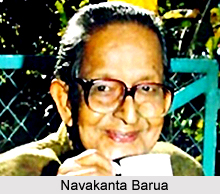 Navakanta Barua thrives to be the poet, novelist and writer whose works have had enlightened the readers of Modern Assamese writing for the ages to come.
Navakanta Barua thrives to be the poet, novelist and writer whose works have had enlightened the readers of Modern Assamese writing for the ages to come.
Early Life of Navakanta Barua
Nabakanta Barua was born December 29, 1926 in Guwahati to Nilakanta Barua, a school inspector and later teacher, and Swarnalata Baruani. He had three brothers: Devakanta, Jivakanta, and Sivakanta. (Devakanta Barua also became a well-known Assamese poet, best known for poem collection Sagor dekhisa.) At first the family lived in upper Assam, then moved to Puranigudam and lastly lived in Nagaon town.
He started his education at a nearby school, and then joined govt Mojolia School. In 1933 he was admitted to Nagaon govt boys in class 3, from there he completed his matriculation in 1941. After that he got admitted to Cotton College, but he lost two years due to illness. In 1943, he went to Shantiniketan (West Bengal). In 1947 he completed his B.A. with English honours and in 1953 M. A. from Aligarh Muslim University.
Career of Navakanta Barua
He worked in Uttar Pradesh at Shikohabad at A.K College, but the same year he had joined Jorhat`s Jagannath Barooah College. In 1954 he joined Cotton College and worked there until 1964. From 1964 to 1967 he worked at Assam Madhyamik Shiksha Parisod as an officer of English education. He again joined Cotton College, retiring as a vice principal in 1984. He served as president of Asam Sahitya Sabha`s Dhing Adhibashan in 1968 and presided over "Asom Sahitya Sabha"`s Bishwanath Chariali convention in 1990.
Works of Navakanta Barua
Like Eliot he also believes that poetry requires a language distinct from that of prose, a language rich in suggestions both to the senses and the intellect. Naturally, Navakanta`s poetry tends to become difficult. In this respect, the Assamese poet also holds that poets in our complex civilisation must be difficult. Indian civilisation comprehends great variety and complexity, and this variety and complexity, playing on a refined sensibility, must produce various and complex results. The poet must become more and more comprehensive and more allusive, in order to force language into his thought. Navakanta`s stay in Kolkata and at Shantiniketan in connection with his higher education brought him also under the influence of Rabindranath Tagore, Jibanananda Das, Amiya Chakravarty and some other modern Bengali poets.
Features of Navakanta Barua
Modern poetic diction is marked by a great economy of words. In common with other modern poets Navakanta also has used diction where there are semantic disturbances, words of different levels, and the juxtaposition of difficult Sanskrit and English vocabulary, and dialect words, producing contrast images. Phrases, quotations, pictures and symbols of the European and Indian literatures are freely employed by him to convey a complex sensibility. His symbols are ambiguous; they do not definitely convey one idea, but a spectrum of ideas.
Their beauty and circumambience vary in proportion to the cultural and emotional range of the reader. Sayed Abdul Malik is better known for his short stories. He writes poetry also with left-wing political affiliation. Among the new writers, he is close to the masses not only for his sympathy for them but for the sake of his poetry too. He finds the subjects of his verse in the common experience of man, and to communicate his ideas clearly, he uses the common man`s language and idioms with considerable ease and melody. One can catch, here and there, in Navakanta`s poems music akin to that of Tagore. He is an experimenter in verse-form with a delicate sense of rhythm and symphony of words. He has shown admirable skill in handling metres, rhymed or free or mixed. Like Eliot Navakanta is aware of the monotony and dichotomy of the modern age and the snobbery of the middle class. But he is never caustic. Acceptance of life is the key-note to his poetry. The poet`s feelings and realisations have beautified and ennobled the earth which is no metaphor to him but a warm reality. Even after departure, the poet will ever seek to return to the earth (The Poetry of Return). His love and desire for a fuller and ampler life under the broad blue sky is beautifully expressed in his prayer to the night sky (To the night sky: prayer through the window.)
Navakanta Barua`s poetic works, He Aranya, He Mahanagar (1951), Eti Duti Egharoti Tora (1958), Samrat (1962), Ravan (1963), Manor Khobar (Songs, 1963), and Mor Aru Prithivir (1973), all reveal a symbolic, often surrealistic, often dramatic approach to his depiction of the gradual destruction of modern society. In actuality he was the one to introduce surrealism in Assamese Poetry. He began his writing in the 1940s, and his poetic vision, expressed through a career that has spanned six decades, has established him as one of the leading poets of Assam. Though his approach is modern, his imagery combines the Romantic as well. His subjects include the natural landscape of Assam, especially its rivers, and he falls back on traditional folk songs and folk dances, as well as the colloquial, for his meter. His later works, such as Ratnakar aru Ananya Kabi (1986) and Ekhon Swasa Mukhare (1990), reveal that, though the poet is faced with, and must accept, present-day reality, there are a continued lingering of, a longing for, the idealism and simplicity of the past.
His writing established him as a visionary and an eminent poetic figure; his poetic expressions being symbolic and lucid flow of their own. His poems stand apart as a revolt against the traditional poetic norms. He was the pioneer of the modern Assamese poetry. He could depict the gradual destruction of modern society and torture of human mind and soul. As a novelist he preferred to base his novels chiefly on historical backgrounds and facts.













